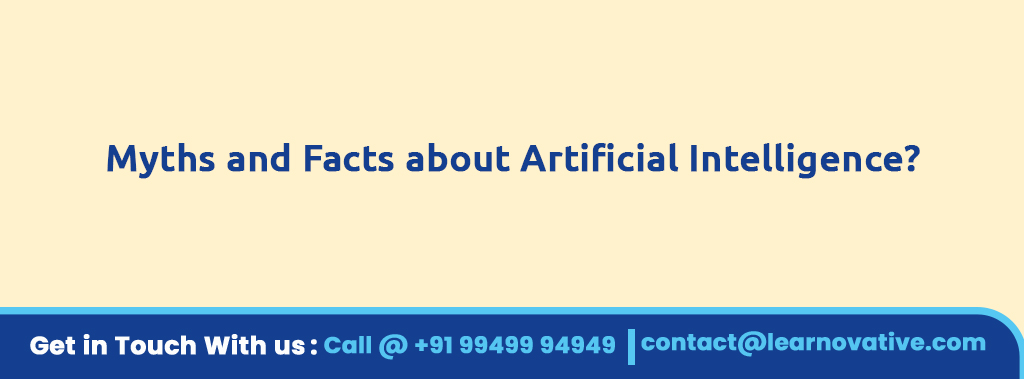
Artificial Intelligence (AI) is everywhere now. AI has penetrated into all sorts of industries including: software, product development, healthcare, manufacturing, automobile, pharmaceutical, infrastructure and so on. However, without proper understanding and awareness of AI it may not give you the expected benefits. In this article, you will understand some important myths and facts about Artificial Intelligence.
1. Myth: AI will replace all human jobs very soon.
Fact:
AI is designed to augment human capabilities, not completely replace humans.
- Reality: While AI automates repetitive tasks, it creates new job opportunities in fields like AI development, data analysis, and robotics.
- Examples: In healthcare, AI assists doctors with diagnostics but doesn’t replace their expertise.
2. Myth: AI systems are always unbiased.
Fact:
AI can be biased if the training data is biased.
- Reality: AI learns from the data it’s trained on. If that data reflects societal biases, the AI system can perpetuate them.
- Solution: Ensuring diverse, high-quality datasets and auditing AI algorithms can minimize biases.
3. Myth: AI can think and feel like humans.
Fact:
AI lacks emotions, consciousness, and self-awareness.
- Reality: AI mimics certain cognitive functions but doesn’t experience emotions or have subjective awareness.
- Example: ChatGPT can respond conversationally but doesn’t “understand” feelings.
4. Myth: AI is infallible and always accurate.
Fact:
AI systems can make mistakes.
- Reality: Accuracy depends on the quality of data, algorithms, and context of use.
- Example: AI-based facial recognition systems can misidentify individuals, especially among underrepresented groups.
5. Myth: AI will take over the world into its control.
Fact:
AI lacks autonomy and operates within human-defined parameters.
- Reality: Current AI is limited to specific tasks (narrow AI) and cannot make decisions independently without human oversight.
- Example: AI assistants like Siri follow user commands but cannot act independently.
6. Myth: AI works like human intelligence.
Fact:
AI processes information differently from the human brain.
- Reality: AI uses algorithms and statistical models, while human intelligence includes intuition, creativity, and emotions.
- Example: AI can calculate probabilities faster but cannot create art with true emotional depth.
7. Myth: AI can learn and improve on its own without limits.
Fact:
AI learning depends on the data it receives and the algorithms it uses.
- Reality: AI doesn’t “know” how to improve itself beyond what it is programmed to do. It requires human intervention for major advancements.
8. Myth: AI is only for tech giants and big businesses.
Fact:
AI is increasingly accessible to individuals and small businesses.
- Reality: Open-source platforms and cloud-based AI tools make AI development affordable for small-scale users.
- Example: AI tools like ChatGPT or Canva’s AI-powered design features are accessible to everyone.
9. Myth: AI is inherently dangerous.
Fact:
AI’s risks come from misuse, not its nature.
- Reality: Ethical use and regulation of AI can mitigate risks such as job displacement or data misuse.
10. Myth: AI can understand context perfectly.
Fact:
AI often struggles with nuance and ambiguity.
- Reality: AI lacks the ability to fully grasp context, sarcasm, or cultural subtleties without extensive training.
11. Myth: AI requires huge amounts of data to work.
Fact:
While AI benefits from data, newer techniques reduce dependency.
- Reality: Advancements like few-shot and zero-shot learning enable AI to perform tasks with limited data.
12. Myth: AI can operate independently forever.
Fact:
AI requires regular updates and maintenance.
- Reality: AI systems need ongoing monitoring and retraining to remain effective and relevant.
13. Myth: AI is just about robots.
Fact:
AI spans diverse fields beyond robotics.
- Reality: AI applications include natural language processing, healthcare diagnostics, virtual assistants, and more.
14. Myth: AI development is unregulated.
Fact:
Governments and organizations are actively creating AI regulations.
- Reality: Frameworks like the EU’s AI Act aim to ensure ethical and responsible AI use.
15. Myth: AI is a futuristic concept.
Fact:
AI is already widely used today.
- Reality: AI powers everyday tools like email spam filters, recommendation engines, and voice assistants.
16. Myth: AI can predict the future with certainty.
Fact:
AI predictions are probabilistic, not definitive.
- Reality: AI analyzes patterns in data to estimate likely outcomes but cannot foresee unexpected variables or events.
- Example: AI weather models predict trends but may miss sudden changes in atmospheric conditions.
17. Myth: AI always gets smarter over time.
Fact:
AI can plateau or degrade without continuous improvement and retraining.
- Reality: AI performance depends on fresh data and updates to remain effective. Stagnant models can become obsolete.
- Example: AI fraud detection systems require updates to tackle new fraud techniques.
18. Myth: AI can understand emotions just like humans.
Fact:
AI can detect emotional cues but does not “feel” emotions.
- Reality: AI uses data from facial expressions, tone of voice, or text to infer emotions but lacks genuine emotional understanding.
- Example: AI chatbots can respond empathetically but only simulate emotional awareness.
19. Myth: AI is all about coding and algorithms.
Fact:
AI also relies on domain expertise, data quality, and ethical considerations.
- Reality: Effective AI requires collaboration between technical teams and experts in the application domain.
20. Myth: AI can function without human supervision.
Fact:
Most AI systems require human oversight, especially for critical applications.
- Reality: Human intervention ensures AI systems operate as intended, especially in high-stakes situations like medical diagnostics.
21. Myth: AI will destroy privacy.
Fact:
AI itself doesn’t destroy privacy; improper use of data does.
- Reality: Ethical guidelines and regulations can ensure AI respects privacy. Techniques like differential privacy can protect sensitive data.
22. Myth: AI will make humans lazy.
Fact:
AI automates repetitive tasks, allowing humans to focus on higher-value work.
- Reality: By saving time on mundane jobs, AI can empower humans to innovate and solve complex problems.
23. Myth: AI is immune to cyberattacks.
Fact:
AI systems can be hacked or manipulated.
- Reality: Adversarial attacks, where inputs are subtly altered, can trick AI models into making errors.
- Example: A slightly modified stop sign could confuse an AI-powered self-driving car.
24. Myth: AI decisions are transparent and easy to explain.
Fact:
AI, especially deep learning models, often operates like a “black box.”
- Reality: Explainable AI (XAI) is an emerging field focused on making AI decisions more understandable.
25. Myth: AI is inherently creative.
Fact:
AI generates outputs based on patterns in existing data, not true creativity.
- Reality: AI can produce art, music, or text that mimics creativity but lacks the human ability to create from imagination or personal experience.
26. Myth: AI works flawlessly with all languages.
Fact:
AI struggles with lesser-studied or regional languages due to limited training data.
- Reality: While major languages like English or Spanish have robust AI tools, less common dialects often face challenges.
27. Myth: AI requires expensive infrastructure to use.
Fact:
AI tools are increasingly affordable and scalable.
- Reality: Cloud-based AI services allow even small businesses to adopt AI without significant upfront costs.
28. Myth: AI is neutral and objective.
Fact:
AI reflects the biases of its creators and data.
- Reality: Developers must consciously work to minimize bias through careful dataset curation and testing.
29. Myth: AI can fully replace human relationships.
Fact:
AI can simulate interaction but cannot replicate genuine human connection.
- Reality: Virtual assistants or AI companions provide support but lack the depth of human empathy and understanding.
By understanding the above Myths and facts about AI anyone can definitely leverage the AI into their professional and personal work and improve their efficiency. If you’re also looking to advance your career, consider CSM training in Hyderabad, explore the benefits of a CSPO course training in Hyderabad, or dive into a CSPO training in Hyderabad to gain a competitive edge in the AI-driven job market.

